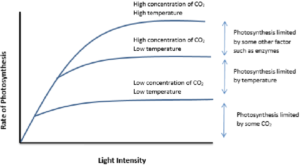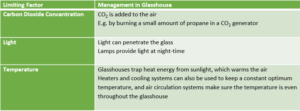Factors Affecting Photosynthesis
A limiting factor limits the rate at which a process can take place. Processes such as photosynthesis are made up of a series of small reactions. It is the slowest of these reactions that determines the overall rate of photosynthesis.
The law of limiting factors is expressed as:
At any given moment, the rate of a physiological process is limited by the factor that is at its least favourable value.
Example
In complete darkness, it is the absence of light alone that prevents photosynthesis occurring. No matter how much we raise or lower the temperature or change the concentration of CO2 there will be no photosynthesis.
Light, or the absence of light, is the factor determining the rate of photosynthesis at that moment. If we provide light the rate of photosynthesis will increase.
As we add more light, the rate increases further.
This does not continue indefinitely because there comes a point at which further increase will have no effect.
At this point, some other factor is in short supply and limits the process. Carbon dioxide for example, is now the limiting factor and only an increase in its level will increase the rate of photosynthesis.
As with light, providing more carbon dioxide will lead to more photosynthesis. Further increase in carbon dioxide level will have no effect on the rate of photosynthesis
The rate of photosynthesis is measured in two ways:
The volume of oxygen released by a plant The volume of carbon dioxide taken up by a plant
Effect of Light Intensity on the Rate of Photosynthesis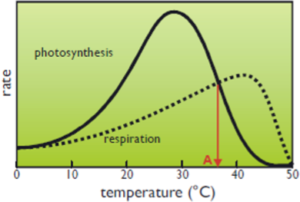
When light is the limiting factor, the rate of photosynthesis is directly proportional to light intensity. As light intensity is increased, the volume of oxygen produced and carbon dioxide absorbed due to photosynthesis will increase to a point at which it is exactly balanced by the oxygen absorbed and the carbon dioxide produced by cellular respiration. At this point there will be no net exchange of gases in or out of the plant – compensation point. Further increase in light intensity will cause a proportional increase in the rate of photosynthesis and increasing volumes of oxygen will be given off and carbon dioxide taken up. A point will be reached at which further increases in light intensity will have no effect on photosynthesis. At this point some other factor is limiting the reaction.
Effect of Carbon Dioxide Concentration on the Rate of Photosynthesis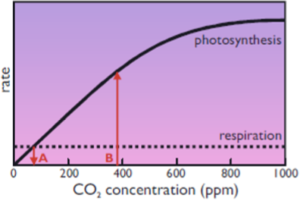
Carbon dioxide is present in the atmosphere at a concentration of around 0.04%. This level continues to increase as a result of human activities such as burning fossil fuels. The optimum concentration of CO2 is 0.1% so growers of some greenhouse crops enrich the air with more carbon dioxide to provide higher yields. Carbon dioxide affects enzyme activity, in particular the enzyme that catalyses the combination of RuBP with CO2 in the light-independent reaction.
Effect of Temperature on the Rate of Photosynthesis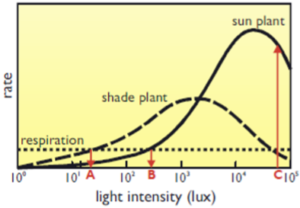
Provided other factors are not limiting, the rate of photosynthesis increases in direct proportion to the temperature. Between 0oC and 25oC the rate of photosynthesis is approximately doubled for each 10oC rise in temperature. In many plants, the optimum temperature is 25oC. Above this temperature the rate levels off and declines – largely as a result of enzyme denaturation. The fact that photosynthesis is temperature-sensitive suggested that there was also a totally chemical process involved as well as photochemical one. We now know the chemical process is the lightindependent reaction.
Growers use information about limiting factors to increase plant growth
Commercial growers know the factors that limit plant growth. This means that they can create an environment where plants get the right amount of everything that they need, which increases growth and so increases yield.
Growers create optimum conditions in the following ways:

